| Listing 1 - 10 of 10 |
Sort by
|
Book
Year: 1936 Publisher: Paris Gauthier-Villars
Abstract | Keywords | Export | Availability | Bookmark
 Loading...
Loading...Choose an application
- Reference Manager
- EndNote
- RefWorks (Direct export to RefWorks)
Book
Year: 1914 Publisher: Bruxelles Imprimerie industrielle et financière
Abstract | Keywords | Export | Availability | Bookmark
 Loading...
Loading...Choose an application
- Reference Manager
- EndNote
- RefWorks (Direct export to RefWorks)
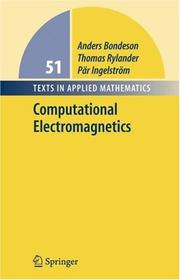
ISBN: 9780387261584 0387261583 1441920846 0387261605 Year: 2005 Publisher: New York Springer
Abstract | Keywords | Export | Availability | Bookmark
 Loading...
Loading...Choose an application
- Reference Manager
- EndNote
- RefWorks (Direct export to RefWorks)
Electromagnetism --- Data processing. --- Mathematical models. --- 535.13 --- Electromagnetics --- Magnetic induction --- Magnetism --- Metamaterials --- 535.13 Electromagnetic theory (Maxwell) --- Electromagnetic theory (Maxwell) --- Data processing --- Mathematical models
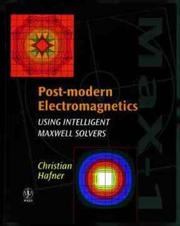
ISBN: 0471987115 9780471987116 Year: 1999 Publisher: New York John Wiley
Abstract | Keywords | Export | Availability | Bookmark
 Loading...
Loading...Choose an application
- Reference Manager
- EndNote
- RefWorks (Direct export to RefWorks)
EMI (electromagnetic interference) --- Electromagnetism. Ferromagnetism --- elektromagnetisme --- 535.13 --- Electromagnetic theory (Maxwell) --- Electromagnetism --- Maxwell equations. --- Mathematics. --- 535.13 Electromagnetic theory (Maxwell) --- Maxwell equations --- Equations, Maxwell --- Differential equations, Partial --- Electromagnetic theory --- Mathematics
Book
ISBN: 9788847015067 9788847015081 9788847015050 9788847055841 Year: 2010 Publisher: Milano Springer Milan
Abstract | Keywords | Export | Availability | Bookmark
 Loading...
Loading...Choose an application
- Reference Manager
- EndNote
- RefWorks (Direct export to RefWorks)
This book deals with the mathematical analysis and the numerical approximation of time-harmonic eddy current problems. It is self-contained and suitable for mathematicians and engineers working in the field, and also accessible for beginners. Depending on the choice of the physical unknowns, these problems are formulated in different variational ways, with specific attention to the topology of the computational domain. Finite elements of nodal or edge type are used for numerical approximation, and a complete analysis of convergence is performed. A specific feature of the book is the emphasis given to saddle-point formulations in terms of the magnetic and electric fields. New results for voltage or current intensity excitation problems are also presented.
Partial differential equations --- Mathematical analysis --- Mathematics --- Planning (firm) --- Computer. Automation --- differentiaalvergelijkingen --- analyse (wiskunde) --- computers --- informatica --- mathematische modellen --- wiskunde --- Eddy currents (Electric) --- Harmonic analysis --- Time-series analysis --- 535.13 --- 535.13 Electromagnetic theory (Maxwell) --- Electromagnetic theory (Maxwell) --- Analysis of time series --- Autocorrelation (Statistics) --- Mathematical statistics --- Probabilities --- Analysis (Mathematics) --- Functions, Potential --- Potential functions --- Banach algebras --- Calculus --- Bessel functions --- Fourier series --- Harmonic functions --- Electric currents --- Mathematical models
Book
ISBN: 1282169106 9786612169106 0080931766 0444529632 0444638911 9780080931760 9780444529633 9780444638915 0444638903 9780444638908 9780444638908 0444638903 Year: 2009 Publisher: Oxford : Elsevier,
Abstract | Keywords | Export | Availability | Bookmark
 Loading...
Loading...Choose an application
- Reference Manager
- EndNote
- RefWorks (Direct export to RefWorks)
In this book the author presents state-of-the-art geophysical electromagnetic (EM) theory and methods of EM geophysics. The book brings together fundamental theory of EM field and practical aspects of EM exploration for mineral and energy resources. The book is divided in four parts covering the foundations of the field theory and its applications to the applied electromagnetic geophysics, including new emerging methods of the marine EM exploration. The first part is an introduction to the field theory required for understanding the basics of geophysical electromagnetic theory. The second
Electromagnetic measurements. --- Prospecting --- Geophysical methods. --- Geophysical prospecting --- Geophysics --- Measurements, Electromagnetic --- Electromagnetic theory --- Frequencies of oscillating systems --- Radiation --- Measurement --- Engineering --- Mining Engineering --- Electromagnetic measurements --- Electromagnetic waves --- Geomagnetism --- Magnetic prospecting --- 535.13 --- 535.13 Electromagnetic theory (Maxwell) --- Electromagnetic theory (Maxwell) --- Earth magnetic field --- Geomagnetic field --- Magnetism, Terrestrial --- Terrestrial magnetic field --- Terrestrial magnetism --- Magnetism --- Electromagnetic energy --- Electromagnetic radiation --- Waves --- Prospecting, Magnetic --- Geophysical methods --- Magnetic prospecting. --- Electromagnetic waves. --- Measurement.
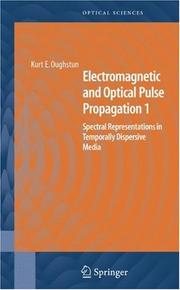
ISBN: 9780387345994 038734599X 0387300708 0387347305 Year: 2006 Publisher: New York, New York : Springer,
Abstract | Keywords | Export | Availability | Bookmark
 Loading...
Loading...Choose an application
- Reference Manager
- EndNote
- RefWorks (Direct export to RefWorks)
Electromagnetic & Optical Pulse Propagation presents a systematic treatment of the radiation and propagation of transient electromagnetic and optical wave fields (such as those used in ultrawideband radar and communications sysyems as well as in ultrashort pulsed optics) through causal, locally linear media which exhibit both temporal dispersion and absorption. Volume I presents a detailed, rigorous development of the fundamental theory of both time and frequency-domain electromagnetics, beginning with the classical Maxwell-Lorentz theory of microscopic electromagnetic fields and ist invariance in the special theory of relativity, the correlation of the microscopic and macroscopic fields, and the angular spectrum representation of pulsed radiation fields in causally dispersive media. The theory provides a rigorous framework for applied research treating temporally pulsed wave fields in dielectric, conducting and semiconducting materials. Volume II presents the asymptotic description of specific pulsed wave fields in both Debye and Lorentz model dielectrics, Drude model conductors and composite model semiconductors.
Electromagnetic theory. --- Wave-motion, Theory of. --- Electromagnetic waves. --- Théorie électromagnétique --- Théorie du mouvement ondulatoire --- Ondes électromagnétiques --- 535.12 --- 535.13 --- Wave theory (Huyghens, Fresnel). Wavelength. Frequency. Wave number --- Electromagnetic theory (Maxwell) --- 535.13 Electromagnetic theory (Maxwell) --- 535.12 Wave theory (Huyghens, Fresnel). Wavelength. Frequency. Wave number --- Physics. --- Optics. --- Electrodynamics. --- Microwaves. --- Optical engineering. --- Optics and Electrodynamics. --- Microwaves, RF and Optical Engineering. --- Classical Electrodynamics. --- Hertzian waves --- Electric waves --- Electromagnetic waves --- Geomagnetic micropulsations --- Radio waves --- Shortwave radio --- Dynamics --- Physics --- Light --- Mechanical engineering --- Electromagnetism. --- Electromagnetics --- Magnetic induction --- Magnetism --- Metamaterials
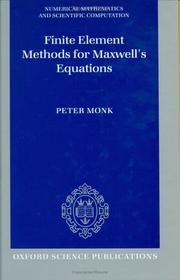
ISBN: 0198508883 9780198508885 Year: 2003 Publisher: Oxford : Clarendon press,
Abstract | Keywords | Export | Availability | Bookmark
 Loading...
Loading...Choose an application
- Reference Manager
- EndNote
- RefWorks (Direct export to RefWorks)
Comprehensive treatment of edge finite element methods Variational theory of Maxwell's equations Error analysis of finite element methods Background material in functional analysis and Sobolev space theory Introduction to inverse problems Since the middle of the last century, computing power has increased sufficiently that the direct numerical approximation of Maxwell's equations is now an increasingly important tool in science and engineering. Parallel to the increasing use of numerical methods in computational electromagnetism there has also been considerable progress in the mathematical understanding of the properties of Maxwell's equations relevant to numerical analysis. The aim of this book is to provide an up to date and sound theoretical foundation for finite element methods in computational electromagnetism. The emphasis is on finite element methods for scattering problems that involve the solution of Maxwell's equations on infinite domains. Suitable variational formulations are developed and justified mathematically. An error analysis of edge finite element methods that are particularly well suited to Maxwell's equations is the main focus of the book. The methods are justified for Lipschitz polyhedral domains that can cause strong singularities in the solution. The book finishes with a short introduction to inverse problems in electromagnetism.
535.13 --- 535.13 Electromagnetic theory (Maxwell) --- Electromagnetic theory (Maxwell) --- finite element method --- computer-aided engineering --- CAE (computer aided engineering) --- Maxwell equations --- Electromagnétisme --- Equations de Maxwell --- Partitial differential equations: domain decomposition methods; elliptic equations; finite difference methods; finite element methods; finite volume methods; hyperbolic equations; inverse problems; iterative solution techniques; methods of lines; multigrid and multilevel methods; parabolic equations; special methods --- Maxwell equations. --- Electromagnétisme --- Electromagnetism --- Finite element method --- Electromagnetics --- Magnetic induction --- Magnetism --- Metamaterials --- Equations, Maxwell --- Differential equations, Partial --- Electromagnetic theory --- FEA (Numerical analysis) --- FEM (Numerical analysis) --- Finite element analysis --- Numerical analysis --- Isogeometric analysis --- Mathematical models --- 519.63 --- 681.3*G18 --- 519.63 Numerical methods for solution of partial differential equations --- Numerical methods for solution of partial differential equations --- Numerical solutions of differential equations --- Functional analysis --- eindige elementen --- Finite element method. --- Mathematical models. --- Méthode des éléments finis --- Modèles mathématiques --- Electromagnetism - Mathematical models --- Equations aux derivees partielles --- Equations de maxwell --- Methodes numeriques --- Elements finis
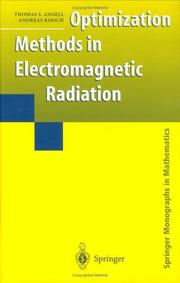
ISBN: 9780387204505 0387204504 9780387218274 1441919147 0387218270 9786610188390 1280188391 Year: 2004 Publisher: New York, NY : Springer New York : Imprint: Springer,
Abstract | Keywords | Export | Availability | Bookmark
 Loading...
Loading...Choose an application
- Reference Manager
- EndNote
- RefWorks (Direct export to RefWorks)
This book considers problems of optimization arising in the design of electromagnetic radiators and receivers. The authors develop a systematic general theory that can be applied to a wide class of structures. The theory is illustrated with familiar, simple examples and indications of how the results can be applied to more complicated structures. The final chapter introduces techniques from multicriteria optimization in antenna design. The material is intended for a dual audience of mathematicians and theoretically-inclined engineers. References to both the mathematics and engineering literature help guide the reader through the necessary mathematical background.
Maxwell equations --- Mathematical optimization. --- Antennas (Electronics) --- Equations de Maxwell --- Optimisation mathématique --- Antennes (Electronique) --- Numerical solutions. --- Design and construction. --- Solutions numériques --- Design et construction --- 535.13 --- Electromagnetic theory (Maxwell) --- Antennas (Electronics) -- Design and construction. --- Maxwell equations -- Numerical solutions. --- Engineering & Applied Sciences --- Applied Mathematics --- Mathematical optimization --- Physics --- Physical Sciences & Mathematics --- Electricity & Magnetism --- Numerical solutions --- Design and construction --- 535.13 Electromagnetic theory (Maxwell) --- Physics. --- Applied mathematics. --- Engineering mathematics. --- Computer mathematics. --- Atoms. --- Microwaves. --- Optical engineering. --- Atomic, Molecular, Optical and Plasma Physics. --- Applications of Mathematics. --- Computational Mathematics and Numerical Analysis. --- Optimization. --- Appl.Mathematics/Computational Methods of Engineering. --- Microwaves, RF and Optical Engineering. --- Numerical analysis --- Optimization (Mathematics) --- Optimization techniques --- Optimization theory --- Systems optimization --- Mathematical analysis --- Maxima and minima --- Operations research --- Simulation methods --- System analysis --- Electronic apparatus and appliances --- Mathematics. --- Computer science --- Mathematical and Computational Engineering. --- Chemistry, Physical and theoretical --- Matter --- Stereochemistry --- Mechanical engineering --- Hertzian waves --- Electric waves --- Electromagnetic waves --- Geomagnetic micropulsations --- Radio waves --- Shortwave radio --- Computer mathematics --- Electronic data processing --- Mathematics --- Engineering --- Engineering analysis --- Natural philosophy --- Philosophy, Natural --- Physical sciences --- Dynamics --- Constitution --- Molecules. --- Telecommunication. --- Atomic, Molecular and Chemical Physics. --- Mathematical and Computational Engineering Applications. --- Microwaves, RF Engineering and Optical Communications. --- Data processing.
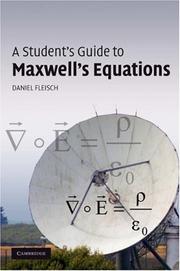
ISBN: 9780521877619 9780521701471 052187761X 0521701473 9780511984624 Year: 2009 Publisher: Cambridge : Cambridge university press,
Abstract | Keywords | Export | Availability | Bookmark
 Loading...
Loading...Choose an application
- Reference Manager
- EndNote
- RefWorks (Direct export to RefWorks)
Gauss's law for electric fields, Gauss's law for magnetic fields, Faraday's law, and the Ampere–Maxwell law are four of the most influential equations in science. In this guide for students, each equation is the subject of an entire chapter, with detailed, plain-language explanations of the physical meaning of each symbol in the equation, for both the integral and differential forms. The final chapter shows how Maxwell's equations may be combined to produce the wave equation, the basis for the electromagnetic theory of light. This book is a wonderful resource for undergraduate and graduate courses in electromagnetism and electromagnetics.
Electromagnetism. Ferromagnetism --- Maxwell equations --- Equations de Maxwell --- Maxwell equations. --- 53 MAXWELL, JAMES CLERK --- 530.14 --- Equations, Maxwell --- Partial differential equations: difference methods elliptic equations finite element methods hyperbolic equations method of lines parabolic equations (Numerical analysis) --- Physics--MAXWELL, JAMES CLERK --- Synthesis of principles of constancy and variability. Atomism in general --- 530.14 Synthesis of principles of constancy and variability. Atomism in general --- 681.3 *G18 Partial differential equations: difference methods elliptic equations finite element methods hyperbolic equations method of lines parabolic equations (Numerical analysis) --- Analyse (wiskunde) --- Elektromagnetisme --- elektromagnetisme --- 517.95 --- 519.63 --- 535.13 --- 681.3*G18 --- 535.13 Electromagnetic theory (Maxwell) --- Electromagnetic theory (Maxwell) --- 681.3 *G18 Partial differential equations: difference methods; elliptic equations; finite element methods; hyperbolic equations; method of lines; parabolic equations (Numerical analysis) --- Partial differential equations: difference methods; elliptic equations; finite element methods; hyperbolic equations; method of lines; parabolic equations (Numerical analysis) --- 519.63 Numerical methods for solution of partial differential equations --- Numerical methods for solution of partial differential equations --- 517.95 Partial differential equations --- Partial differential equations --- Differential equations, Partial --- Electromagnetic theory --- 681.3 *G18 --- Electromagnetism --- Électromagnétisme --- Maxwell, Équations de --- Problems, exercises, etc. --- Problèmes et exercices --- Maxwell, Équations de. --- Problèmes et exercices. --- Électromagnétisme --- Maxwell, Équations de. --- Problèmes et exercices.
| Listing 1 - 10 of 10 |
Sort by
|

 Search
Search Feedback
Feedback About UniCat
About UniCat  Help
Help News
News